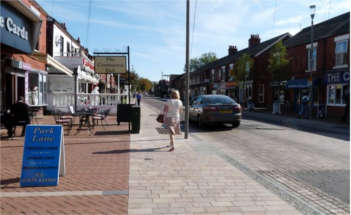New professional guidance due this summer on shared space schemes is set to establish three broad types of public realm arrangement.
The three types of design response will outline a shared space spectrum and help analyse and monitor schemes within a generally understood framework.
The work is being carried out by professional body the Chartered Institution of Highways and Transportation (CIHT), with the Institute of Highways Engineers and the Department for Transport (DfT) also involved, as well as disability groups such at the National Federation of the Blind.

A 'less managed' street under the new guidance
Attendees at the CIHT annual conference were given an update on the work, which has already identified around 14 case studies to take as a basis for the guidance. Those leading on project have also met with transport minister Andrew Jones.
Phil Jones, managing director of Phil Jones Associates, who is working with the CIHT on the guidance, explained: ‘We have agreed a structure for the document and identified 14 case studies, although its possible not all will make it into the final guidance. We will then collate the lessons learned and are aiming for publication some time this summer.’
Street types:
- Type 1: Unstructured street - where there is no or little definition of where in the space a pedestrian, cyclist or motor vehicle might be expected to be
- Type 2: Less managed street – where there are parts of the space, at junctions for instance, with generally clear areas for different types of user but the interaction between them is less managed than on a conventional street, so typically no traffic signals or priority crossings
- Type 3 Enhanced street – Where traffic management is generally conventional in the way it operates.
Initial research for the guidance has found that the so-called ‘courtesy rate’ – rate at which drivers give way to pedestrians – ranged significantly across the three types of public realm from 12% up to 97%, with many more drivers giving way when there are clear crossing areas.
Mr Jones said: ‘The crossings that are more conspicuous, with more [zebra] stripes, do seem to have higher compliance. The one exception is Poynton shared space scheme, which is at 85% even though it has no stripes.’
In a move that is likely to prove controversial with campaigners, the CIHT panel working on the guidance told Transport Network they would stop short of stating such crossings should always be in place.
The guidance is likely to address potential outcomes - including better quality place, ease of movement, improved safety and public health, and economic benefits - to the different public realms.
The study will develop and possibly update the DfT's previous Local transport note: Shared space (1/11) released in December 2011.
Mr Jones said: ‘It is possible that the document we produce might actually become a DfT publication, or have ministerial endorsement. There is an appetite to have some sort of status to it.’
The news follows a widespread anti-shared space campaign that raised major concerns about the impact these projects had on the disabled, particularly the blind.
Conservative peer Lord Holmes, who is blind, launched a report that called for moratorium on such schemes until further research could be carried out.
In response the DfT wrote to every authority asking for information on schemes that they considered to be shared space and that information has been passed to the CIHT team.